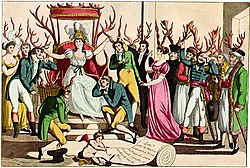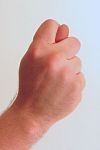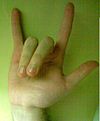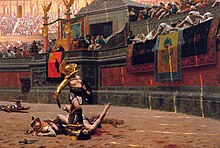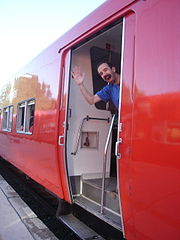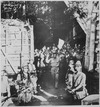
A salute is usually a formal hand gesture or other action used to display respect in military situations. Salutes are primarily associated with the military and law enforcement, but many civilian organizations, such as Girl Guides, Boy Scouts and the Salvation Army use formal salutes. Ordinary civilians also salute informally to greet or acknowledge the presence of another person, such as a tip of the hat or a hand wave to a friend or neighbor.

In Western culture, "the finger", or the middle finger also represented as "🖕" is an obscene hand gesture. The gesture communicates moderate to extreme contempt, and is roughly equivalent in meaning to "fuck you", "fuck me", "shove it up your ass/arse", "up yours", or "go fuck yourself". It is performed by showing the back of a hand that has only the middle finger extended upwards, though in some locales, the thumb is extended. Extending the finger is considered a symbol of contempt in several cultures, especially in the Western world. Many cultures use similar gestures to display their disrespect, although others use it to express pointing without intentional disrespect. The gesture is usually used to express contempt but can also be used humorously or playfully.

The V sign is a hand gesture in which the index and middle fingers are raised and parted to make a V shape while the other fingers are clenched. It has various meanings, depending on the circumstances and how it is presented.

The two-finger salute is a salute given using only the middle and index fingers, while bending the other fingers at the second knuckle, and with the palm facing the signer. This salute is used by the Polish Armed Forces, other uniformed services in Poland, and, in some countries, the Cub Scouts.

Diver communications are the methods used by divers to communicate with each other or with surface members of the dive team. In professional diving, diver communication is usually between a single working diver and the diving supervisor at the surface control point. This is considered important both for managing the diving work, and as a safety measure for monitoring the condition of the diver. The traditional method of communication was by line signals, but this has been superseded by voice communication, and line signals are now used in emergencies when voice communications have failed. Surface supplied divers often carry a closed circuit video camera on the helmet which allows the surface team to see what the diver is doing and to be involved in inspection tasks. This can also be used to transmit hand signals to the surface if voice communications fails. Underwater slates may be used to write text messages which can be shown to other divers, and there are some dive computers which allow a limited number of pre-programmed text messages to be sent through-water to other divers or surface personnel with compatible equipment.

A mudra is a symbolic or ritual gesture or pose in Hinduism, Jainism and Buddhism. While some mudras involve the entire body, most are performed with the hands and fingers.

Greeting is an act of communication in which human beings intentionally make their presence known to each other, to show attention to, and to suggest a type of relationship or social status between individuals or groups of people coming in contact with each other. Greetings are sometimes used just prior to a conversation or to greet in passing, such as on a sidewalk or trail. While greeting customs are highly culture- and situation-specific and may change within a culture depending on social status and relationship, they exist in all known human cultures. Greetings can be expressed both audibly and physically, and often involve a combination of the two. This topic excludes military and ceremonial salutes but includes rituals other than gestures. A greeting, or salutation, can also be expressed in written communications, such as letters and emails.

The index finger is the second digit of a human hand. It is located between the thumb and the middle finger. It is usually the most dextrous and sensitive digit of the hand, though not the longest. It is shorter than the middle finger, and may be shorter or longer than the ring finger.

The three-finger salute is used by members of Scout and Guide organizations around the world when greeting other Scouts and in respect of a national flag at ceremonies. In most situations, the salute is made with the right hand, palm face out, the thumb holding down the little finger. There are some variations of the salute between national Scouting organizations and also within some programme sections.

The shaka sign, sometimes known as "hang loose" is a gesture with friendly intent often associated with Hawaii and surf culture. It consists of extending the thumb and smallest finger while holding the three middle fingers curled, and gesturing in salutation while presenting the front or back of the hand; the wrist may be rotated back and forth for emphasis. The shaka sign is similar to the letter Y in the American manual alphabet in American Sign Language. The shaka sign should not be confused with the sign of the horns, where the index and pinky finger are extended and the thumb holds down the middle two fingers.
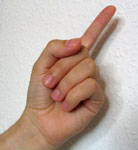
Chinese number gestures are a method to signify the natural numbers one through ten using one hand. This method may have been developed to bridge the many varieties of Chinese—for example, the numbers 4 and 10 are hard to distinguish in some dialects. Some suggest that it was also used by business people during bargaining when they wish for more privacy in a public place. These gestures are fully integrated into Chinese Sign Language.

The OK gesture or OK sign or ring gesture is performed by joining the thumb and index finger in a circle, and holding the other fingers straight or relaxed away from the palm. Commonly used by scuba divers, it signifies "I am OK" or "Are you OK?" when underwater. In most English-speaking countries it denotes approval, agreement, and that all is well or "okay". In other contexts or cultures, similar gestures may have different meanings including those that are negative, offensive, financial, numerical, devotional, political, or purely linguistic.
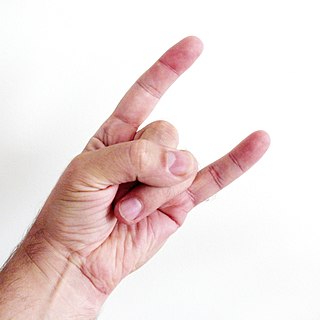
The sign of the horns is a hand gesture with a variety of meanings and uses in various cultures. It is formed by extending the index and little fingers while holding the middle and ring fingers down with the thumb.

A thumb signal, usually described as a thumbs-up or thumbs-down, is a common hand gesture achieved by a closed fist held with the thumb extended upward or downward, respectively. The thumbs-up gesture is associated with positivity, approval, achievement, satisfaction and solidarity, while the thumbs-down gesture is associated with concern, disapproval, dissatisfaction, rejection and failure.
A taunt is a battle cry, sarcastic remark, gesture, or insult intended to demoralize the recipient, or to anger them and encourage reactionary behaviors without thinking. Taunting can exist as a form of social competition to gain control of the target's cultural capital. In sociological theory, the control of the three social capitals is used to produce an advantage in the social hierarchy, so as to enforce one's own position in relation to others. Taunting is committed by either directly or indirectly encouraging others to taunt the target. The target may give a response in kind to maintain status, as in fighting words and trash-talk.
American Sign Language (ASL), the sign language used by the deaf community throughout most of North America, has a rich vocabulary of terms, which include profanity. Within deaf culture, there is a distinction drawn between signs used to curse versus signs that are used to describe sexual acts. In usage, signs to describe detailed sexual behavior are highly taboo due to their graphic nature. As for the signs themselves, some signs do overlap, but they may also vary according to usage. For example, the sign for "shit" when used to curse is different from the sign for "shit" when used to describe the bodily function or the fecal matter.

Finger-counting, also known as dactylonomy, is the act of counting using one's fingers. There are multiple different systems used across time and between cultures, though many of these have seen a decline in use because of the spread of Arabic numerals.
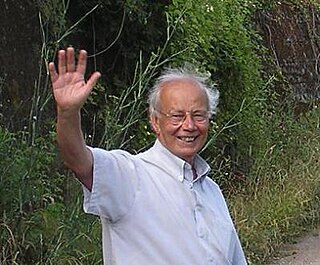
Waving is a nonverbal communication gesture that consists of the movement of the hand and/or entire arm that people commonly use to greet each other, but it can also be used to say goodbye, acknowledge another's presence, call for silence, or deny someone. The wave gesture is an essential element of human language.

An Esperanto manual alphabet is included as part of the Signuno project for manually coded Esperanto. Signuno is based on the signs of International Sign, but adapted to the grammatical system of Esperanto.

The Fist-and-palm gesture, also known as Gongshou, or Zuoyi in Chinese, is a traditional Chinese ceremonial gesture or salute used for greeting or showing respect. It involves bringing together the index finger, middle finger, ring finger, and little finger of both hands, with the palms facing inward or downward and the thumbs of each hand interlocking. One hand is placed over the other, and generally, the left-hand covers the right one for men and is reversed for women. There are different variants depending on conditions, such as gender, occasion and relationship between the individuals. Additional hand and body movements such as bowing may be used with the gesture.



